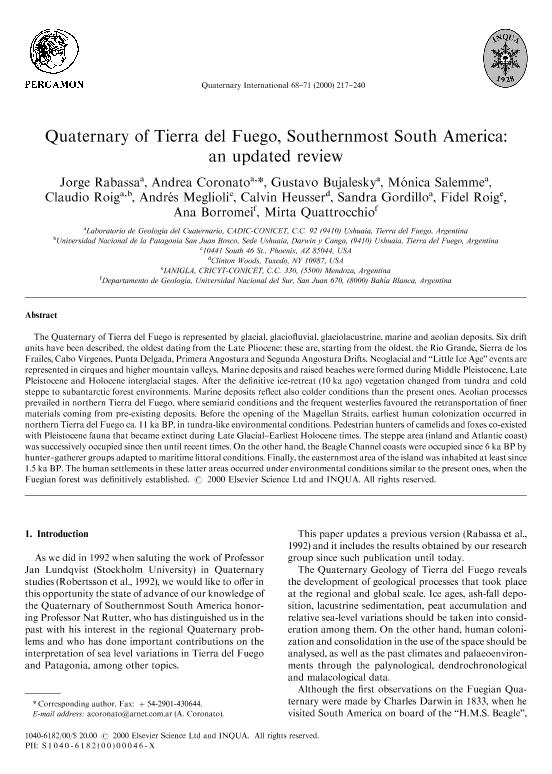Mostrar el registro sencillo del ítem
dc.contributor.author
Rabassa, Jorge Oscar

dc.contributor.author
Coronato, Andrea Maria Josefa

dc.contributor.author
Bujalesky, Gustavo Gabriel

dc.contributor.author
Salemme, Monica Cira

dc.contributor.author
Roig, Claudio
dc.contributor.author
Meglioli, Andrés
dc.contributor.author
Heusser, Calvin
dc.contributor.author
Gordillo, Sandra

dc.contributor.author
Roig Junent, Fidel Alejandro

dc.contributor.author
Borromei, Ana Maria

dc.contributor.author
Quattrocchio, Mirta Elena

dc.date.available
2019-10-22T16:10:30Z
dc.date.issued
2000-06
dc.identifier.citation
Rabassa, Jorge Oscar; Coronato, Andrea Maria Josefa; Bujalesky, Gustavo Gabriel; Salemme, Monica Cira; Roig, Claudio; et al.; Quaternary of Tierra del Fuego, Southernmost South America: an updated review; Pergamon-Elsevier Science Ltd; Quaternary International; 68-71; 6-2000; 217-240
dc.identifier.issn
1040-6182
dc.identifier.uri
http://hdl.handle.net/11336/86869
dc.description.abstract
The Quaternary of Tierra del Fuego is represented by glacial, glaciofluvial, glaciolacustrine, marine and aeolian deposits. Six drift units have been described, the oldest dating from the Late Pliocene: these are, starting from the oldest, the Río Grande, Sierra de los Frailes, Cabo Vírgenes, Punta Delgada, Primera Angostura and Segunda Angostura Drifts. Neoglacial and ?Little Ice Age? events are represented in cirques and higher mountain valleys. Marine deposits and raised beaches were formed during Middle Pleistocene, Late Pleistocene and Holocene interglacial stages. After the definitive ice-retreat (10 ka ago) vegetation changed from tundra and cold steppe to subantarctic forest environments. Marine deposits reflect also colder conditions than the present ones. Aeolian processes prevailed in northern Tierra del Fuego, where semiarid conditions and the frequent westerlies favoured the retransportation of finer materials coming from preexisting deposits. Before the opening of the Magellan Straits, earliest human colonization occurred in northern Tierra del Fuego ca. 11 ka BP, in tundra-like environmental conditions. Pedestrian hunters of camelids and foxes co-existed with Pleistocene fauna that became extint during Late Glacial-Earliest Holocene times. The steppe area (inland and Atlantic coast) was successively occupied since then until recent times. On the other hand, the Beagle Channel coasts were occupied since 6 ka BP by hunter-gatherer groups adapted to maritime littoral conditions. Finally, the easternmost area of the island was inhabited at least since 1.5 ka BP. The human settlements in these latter areas occurred under environmental conditions similar to the present ones, when the Fuegian forest was definitively established.
dc.format
application/pdf
dc.language.iso
eng
dc.publisher
Pergamon-Elsevier Science Ltd

dc.rights
info:eu-repo/semantics/openAccess
dc.rights.uri
https://creativecommons.org/licenses/by-nc-sa/2.5/ar/
dc.subject
Geology
dc.subject
Quaternary
dc.subject
Tierra del Fuego
dc.subject.classification
Otras Ciencias Naturales y Exactas

dc.subject.classification
Otras Ciencias Naturales y Exactas

dc.subject.classification
CIENCIAS NATURALES Y EXACTAS

dc.title
Quaternary of Tierra del Fuego, Southernmost South America: an updated review
dc.type
info:eu-repo/semantics/article
dc.type
info:ar-repo/semantics/artículo
dc.type
info:eu-repo/semantics/publishedVersion
dc.date.updated
2019-06-03T14:26:44Z
dc.journal.volume
68-71
dc.journal.pagination
217-240
dc.journal.pais
Estados Unidos

dc.description.fil
Fil: Rabassa, Jorge Oscar. Consejo Nacional de Investigaciones Científicas y Técnicas. Centro Austral de Investigaciones Científicas; Argentina
dc.description.fil
Fil: Coronato, Andrea Maria Josefa. Consejo Nacional de Investigaciones Científicas y Técnicas. Centro Austral de Investigaciones Científicas; Argentina
dc.description.fil
Fil: Bujalesky, Gustavo Gabriel. Consejo Nacional de Investigaciones Científicas y Técnicas. Centro Austral de Investigaciones Científicas; Argentina
dc.description.fil
Fil: Salemme, Monica Cira. Consejo Nacional de Investigaciones Científicas y Técnicas. Centro Austral de Investigaciones Científicas; Argentina
dc.description.fil
Fil: Roig, Claudio. Consejo Nacional de Investigaciones Científicas y Técnicas. Centro Austral de Investigaciones Científicas; Argentina. Universidad Nacional de la Patagonia "San Juan Bosco"; Argentina
dc.description.fil
Fil: Meglioli, Andrés. No especifica;
dc.description.fil
Fil: Heusser, Calvin. No especifica;
dc.description.fil
Fil: Gordillo, Sandra. Consejo Nacional de Investigaciones Científicas y Técnicas. Centro Austral de Investigaciones Científicas; Argentina
dc.description.fil
Fil: Roig Junent, Fidel Alejandro. Consejo Nacional de Investigaciones Científicas y Técnicas. Centro Científico Tecnológico Conicet - Mendoza. Instituto Argentino de Nivología, Glaciología y Ciencias Ambientales. Provincia de Mendoza. Instituto Argentino de Nivología, Glaciología y Ciencias Ambientales. Universidad Nacional de Cuyo. Instituto Argentino de Nivología, Glaciología y Ciencias Ambientales; Argentina. Ministerio de Relaciones Exteriores, Comercio Internacional y Culto. Direccion Nacional del Antártico. Instituto Antártico Argentino. Instituto Antártico Argentino - Sede Cricyt (Mendoza); Argentina
dc.description.fil
Fil: Borromei, Ana Maria. Consejo Nacional de Investigaciones Científicas y Técnicas; Argentina. Universidad Nacional del Sur. Departamento de Geología; Argentina
dc.description.fil
Fil: Quattrocchio, Mirta Elena. Consejo Nacional de Investigaciones Científicas y Técnicas; Argentina. Universidad Nacional del Sur. Departamento de Geología; Argentina
dc.journal.title
Quaternary International

dc.relation.alternativeid
info:eu-repo/semantics/altIdentifier/doi/https://doi.org/10.1016/S1040-6182(00)00046-X
dc.relation.alternativeid
info:eu-repo/semantics/altIdentifier/url/https://www.sciencedirect.com/science/article/pii/S104061820000046X
Archivos asociados
